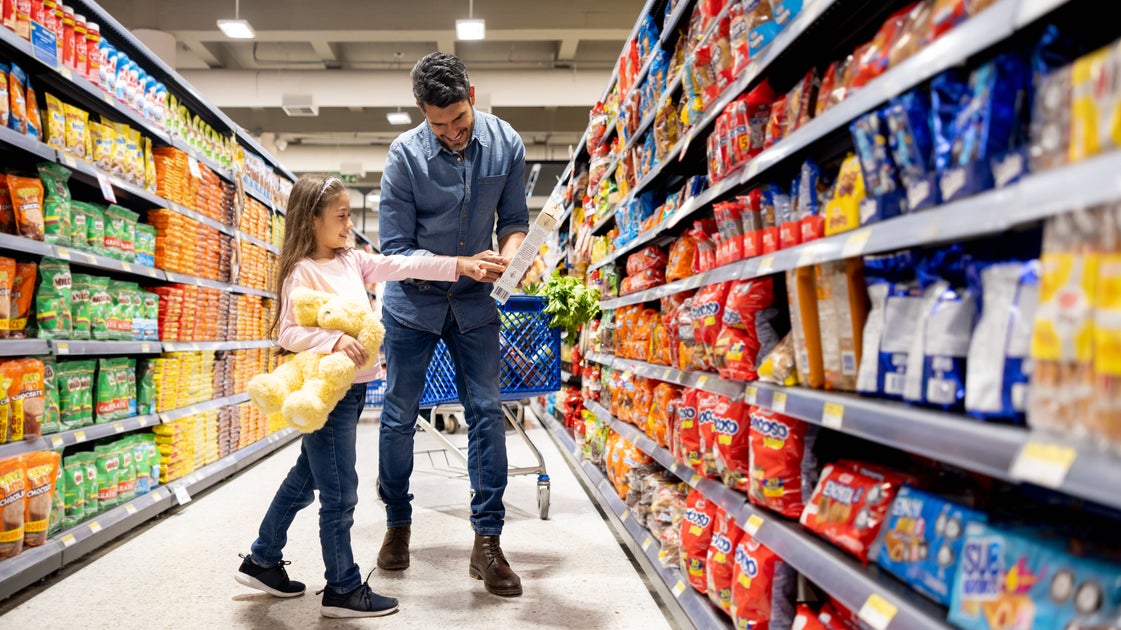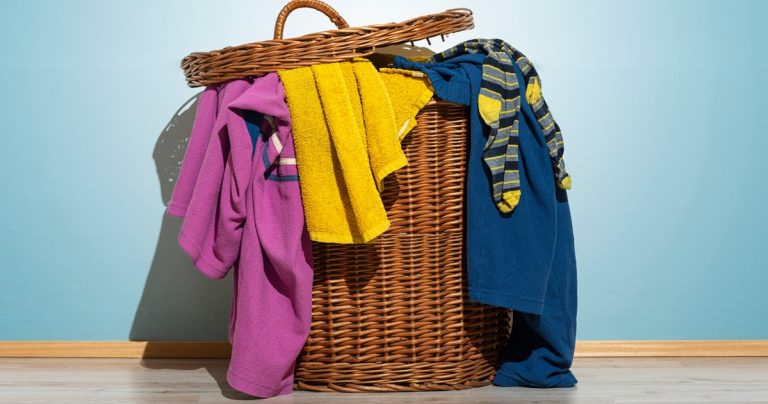
If you’ve ever muttered to yourself, “I should really get the organic peaches,” or “I need to replace my old makeup with ‘clean’ beauty products” or “I really want to buy the “non-toxic’ laundry detergent,” you may have fallen into the chemophobia trap, an almost inescapable phobia that’s infiltrating lots of homes.
Chemophobia is complicated, but, in short, it’s a distrust or fear of chemicals and appears in many of aspects of life from “chemical-free” soaps and “natural” deodorants to vaccine distrust and fear-mongering about seed oils.
But, unlike most things, it plays on the emotions of both conservative MAGA voters and liberal MAGA opposers, even though actual chemophobia-based thoughts vary significantly in each group.
“Much of this started on the left-leaning side of the political aisle as a result of misunderstanding the difference between legitimate chemical industrial incidents and just chemicals more broadly,” said Andrea Love, an immunologist, microbiologist and founder of Immunologic, a health and science communication organization.
Appealing to the left, it was seen as counter-culture and opposed the “evil market forces,” said Timothy Caulfield, the co-founder of ScienceUpFirst, an organization that combats misinformation, and author of “The Certainty Illusion.”
“But now we’re seeing it shift to the right, and I think it’s almost now entirely on the right, or at least the loudest voices … are on the right,” Caulfield noted. These are voices like Casey Means, a wellness influencer and surgeon general nominee, and even Robert F. Kennedy, Jr., the Health and Human Services secretary.
On the right-leaning side, chemophobia appears as a distrust and demonization of things like studied vaccines and medications and the pushing of “natural” interventions, “when those have no regulatory oversight compared to regulated medicines,” Love noted.
“On the left-leaning [side], this gets a lot of attention because it plays into this fear of toxic exposures, and this ‘organic purity’ narrative … ‘you have to eat organic food, and you can’t have GMOs,’” Love said.
No matter your political party, chemophobia has infiltrated people’s homes, diets and minds, while also infiltrating brand slogans, marketing campaigns and political messaging (ahem, Make America Healthy Again). Here’s what to know:
Chemophobia says you should avoid chemicals, but that’s impossible — water is a chemical and you are made up of chemicals.
“First of all, everything is chemicals,” said Love. “Your body is a sack of chemicals. You would not exist if it were not for all these different chemical compounds.”
Chemophobia leads people to believe that synthetic, lab-made substances are inherently bad while “natural substances” — things found in nature — are inherently good, and that is just not true, Love said.
The current obsession with “all-natural” beef tallow as a replacement for “manufactured” seed oils is a prime example of this.
“Your body … has no idea if it’s a synthetic chemical, meaning it was synthesized in a lab using chemical reactions, or if it exists somewhere out on the planet,” Love added.
Your body doesn’t know the difference between getting vitamin C from a lime and getting vitamin C that’s made in a lab, she explained.
Your body only cares about the chemical structure (which is the same in synthetic chemicals and natural chemicals) and the dosage you’re being exposed to, Love noted.
“This irrational fear of chemicals, just by and large, is antithetical to life because chemistry and chemicals are why everything exists,” Love said.
Everything that is made up of matter is a network of chemicals, she explained. That goes for your body, your pets, your car, your TV, your home and the food you eat.
“Everything is just these structures of chemicals linked together into physical objects … so, there’s zero reason to be afraid of chemicals broadly,” said Love.
Chemophobia was born from the ‘appeal to nature fallacy’ and a desire to ‘get back to ancestral living.’
Chemophobia was born from the “appeal to nature fallacy,” said Love, which is “the false belief that natural substances … are inherently safe, beneficial or superior, whereas synthetic substances are inherently bad, dangerous, harmful or worse than a natural counterpart.”
There is nothing legitimate about this belief, she added. But both chemophobia and the appeal to nature fallacy are central to pseudoscience, the anti-vaccine movement and the MAHA wellness industry, Love noted.
At the core of chemophobia and appeal to nature fallacy is also a “romanticization of ancestral living, when, in reality, we lived very poorly, we died very young and often suffering and in pain,” Love said.
“Going back to simpler times” are talking points for both MAHA and MAGA, which, of course, stands for “Make America Great Again,” a slogan that alludes to the past. And, RFK Jr. has repeatedly claimed America was healthier when his uncle, John F. Kennedy, was president.
This is complicated, but not true; two out of three adults died of chronic disease and life expectancy was almost 10 years less than it is now, according to NPR.
Chemophobia is designed to elicit negative emotions such as anxiety and fear.
Chemophobia is incredibly effective because it evokes people’s negative emotions, said Love. And it’s hard for most people to separate emotions from facts.
If someone on social media says that a certain ingredient is harming your kids, you’ll be scared and want to make lifestyle changes. If someone claims your makeup is bad for you, you’ll also be scared and want to make changes.
“Take, for example, fructose, since it’s having a moment,” said Andrea Hardy, a dietitian and owner of Ignite Nutrition, who is referring to a viral social media video about the “harms” of fructose.
“An influencer online might say ‘fructose is bad, the liver can’t handle it, we shouldn’t be eating any fructose. I’ve cut all fructose from my diet and I’m the healthiest I’ve ever been.’ Then a mom, wanting to do the best for her children says, ‘I need to cut out all fructose’ and not only removes the ultra-processed foods like sweetened beverages, but also says no to fruit in her household because of this misinformation,” Hardy said.
This has lots of consequences, including a lack of nutrition in the home (from missing out on the fiber and vitamins from fruit) and the encouragement of disordered eating in kids, who, from this elimination of fructose, will learn the false idea that “fruit is bad” or “fructose is bad,” explained Hardy.
Illustration: HuffPost; Photos: Getty
Our brains want clear, black-and-white information. Vilifying one product while celebrating another achieves that.
Between social media and the internet, we live in a “chaotic information environment,” according to Caulfield.
There’s seemingly factual information coming at you from everywhere, and it can be hard to know what to trust.
“The reality is, our brains want simple. They want black and white,” said Hardy.
We make choices all day long, which makes categorizing things, like food, as “good or bad” appealing to our minds, Hardy said.
And, everyone wants to make the “good” choice, Caulfield added. “We want to do what’s best for ourselves and for the environment and for our community and our family,” he said.
As a result, we look for “clear signals of goodness,” or “short cuts to making the right decision,” added Caulfield. We turn not only to words like “good” or “bad,” but also “toxin-free,” “natural” and “clean,” he said.
Seeing these words slapped on a jar of nut butter, on a shampoo bottle, or on sunscreen makes making the “right choice” easier, he added — “even though the evidence does not support what’s implied by those words, those ‘health halos,’” noted Caulfield.
These words are an “oversimplification,” Hardy said. “People now leverage their social media presence to share those oversimplified nutrition messages, most of which are at best, wrong, at worst, harmful.”
Chemophobia is really hard to escape. It’s even built into marketing campaigns and product names.
If you’ve ever fallen into the chemophobia trap without knowing, you aren’t alone. It’s complicated and nuanced, and the science is, at times, messy.
Moreover, chemophobia is the inspiration behind brand names and entire product categorizations; “clean beauty” is one huge example.
Fears of chemicals are now marketing ploys. “You’re going to find products that claim that they’re ‘chemical-free,’ and that doesn’t exist,” Love said, referring to the fact that, once again, everything is made up of chemicals.
Market forces take over and cling to the chemophobia buzz words of the moment, whether that’s “clean” “gluten-free” or “non-GMO,” Caulfield said.
Now, we have Triscuits labeled with non-GMO marketing, he said. We also have entire product lines at stores like Sephora that are categorized as “clean.”
“It creates this perception [of] ‘if that one’s chemical-free, then the alternative that isn’t labeled as such must be dangerous, must be bad,’” Love said.
Once again, making the “good” choice easy.
This isn’t to say there isn’t room for improvement in the health and food space.
“I work in the public health space. I don’t know a single public health researcher, a single agricultural researcher, a single biomedical researcher who doesn’t want to make our food environment safer for everyone,” said Caulfield.
Just because Caulfield speaks out against chemophobia doesn’t mean he doesn’t want to make our food and health environment healthier, he stressed.
“I do think we should always be challenging both industry and government to do exactly that, but at the same time, we have to be realistic and understand the nature of the risks and the magnitude of risks at play,” he said.
Both our food environment and agricultural practices could be safer, “but those moves should be based on what the science says, and not on slogans,” Caulfield said.
Corporate greed and capitalism hinder these safety changes.
“The huge irony here … the answer to all of these chemophobia concerns … it’s more government regulation. It’s more robust, science-informed regulation. And in this political environment, that ain’t going to happen, That just simply isn’t going to happen, as we’ve already seen,” Caulfield said.
The Trump administration wants to repeal environmental protections that help fight climate change (and the air we breathe has huge health implications) and has cut funding to departments that are in charge of food safety, which could jeopardize the items you buy at the grocery store.
“So, it all just becomes slogans and wellness nonsense,” along with the peddling of unregulated, unproven supplements (that are basically just untested chemicals), Caulfield added.
And, many of the people who claim to be so concerned about chemicals then profit from the sale of unregulated supplements, Caulfield said.

Jeff Greenberg via Getty Images
Focusing on one ‘bad’ ingredient or so-called ‘natural’ alternatives won’t actually make you healthier.
This fear of chemicals will have an enormous impact and is “something we won’t even realize and see the effects of for years to come,” Hardy said.
“If we want to improve public health, focusing on a single ingredient in food or swapping seed oils for beef tallow isn’t the answer to our public health problems, it’s a distraction,” Hardy said.
Food dyes, seed oils, “non-clean” beauty, whatever the item may be, become a common enemy, allowing folks to ignore the fact that this isn’t actually a problem that’s central to the country’s health outcomes, Love added.
RFK Jr. has claimed that “Americans are getting sicker” and research does show that America has worse health outcomes while spending more on health care than other Western countries, but it’s too simple (and flat-out wrong) to blame any one makeup chemical or item in your pantry.
“Instead of critically assessing and saying, ’Hey, we do have some health challenges, but what are the underlying factors to that? Maybe it’s housing inequity and lack of national health care and all of these societal, structural issues, and it’s not these singular food ingredients,” Love said.
“These conversations distract us from the real things that we can do to make ourselves and our communities healthier, and I think that’s one of the biggest problems with MAHA,” said Caulfield.
“No one’s a huge food dye fan. I’m not going to go to the mat for food dye [but] … all these are distractions from the things that really matter to make us, to make our communities healthier — equity, justice, access to health care, education, gun laws — these are the things that, on a population level, are really going to make a difference,” Caulfield said.
Whether someone has conservative or liberal views that fuel their chemophobia, the fear of chemicals is dangerous. And, it’s, sadly, more prevalent than ever, Caulfield said.
It’s causing people to say no to necessary vaccines, not wear sunblock out of fears of “toxins,” avoid fruit because of fructose and more.
“This is going to kill people … this is really serious stuff, and it’s an incredible time in human history in the worst possible way,” Caulfield said.




